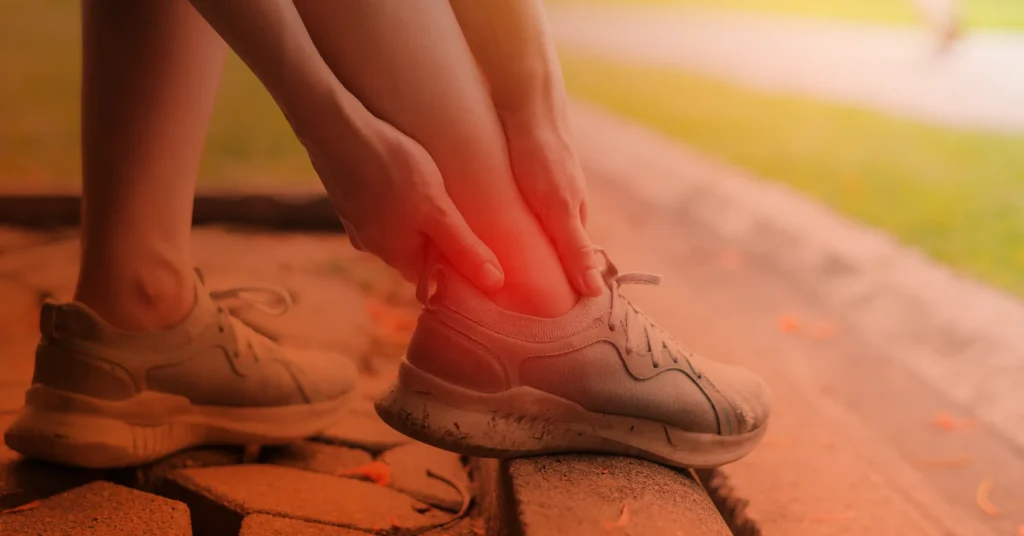Repetitive stress in the lower legs and ankles can lead to a painful injury called Achilles tendinitis. Discover the details of this common condition, including treatment and prevention.
Achilles tendinitis is an overuse injury that causes inflammation of the Achilles tendon, which is the thick tendon that connects the muscle of the calf to the heel bone (calcaneus).
It commonly affects athletes but it can affect anyone involved in recreational athletic activity and sports.
Though a painful condition, Achilles tendinitis is perfectly treatable. Let’s take a look at how to tackle this injury and get back on the path to recovery.
Signs and Symptoms of Achilles Tendinitis
Achilles tendinitis is caused by straining of the tendons in the back of the foot. Running, court sports, and other activities that involve high impacts on the foot risk this injury.
Here are some of the telltale signs you might have Achilles tendinitis:
- Pain: Pain is typically felt in the back of the ankle along the Achilles tendon. You might feel pain anywhere across the tendon, but more often than not it occurs just under the calf.
- Swelling: There can be mild swelling around the tendon.
- Stiffness: Reduced flexibility, tightness, and a general lack of movement are all common with overused tendons in the ankle.
- Tenderness: The tendon might be tender to the touch.
Risk Factors of Achilles Tendinitis
Though tendinitis is a common sporting injury, you don’t have to be a fitness fanatic to be at risk. The injury can affect a wide range of people.
Some of the factors that might increase your chance of injuring your Achilles include:
- Age: Patients over 30 years of age are more prone to experiencing Achilles tendinitis.
- Hobbies: High-impact hobbies, like running and court sports, can increase the risk of tendinitis in the ankle.
- Improper Footwear: Poorly-fitting shoes or those without adequate ankle support, can risk potential injury.
- Tight Calf Musculature: Limited flexibility due to tight calf musculature can increase stress on the Achilles tendons.
- Sudden Increase in Activity: Rapid increases in the intensity or frequency of physical activity can overload the tendon, causing pain and inflammation.
How Achilles Tendinitis is Diagnosed
A professional physical therapist can help diagnose an Achilles tendon injury. If you’re suffering from tendon pain in the ankle, it’s best to book an appointment with your nearest orthopedic surgeon.
Here’s how a physical therapist might diagnose your injury:
Physical examination:
A physical examination will help determine your range of motion, stiffness, and tenderness in the ankle. The therapist will likely want to determine where in the ankle the pain originates.
They will likely ask questions about your lifestyle, when the pain started, and any activities or sports you might be involved in.
Ultrasound:
Diagnostic ultrasound tests can identify any swelling or inflammation around the ankle.
MRI:
An MRI scan can help determine the severity of the injury and the extent of the damage to the tendons.
How to Treat Achilles Tendinitis
Once you’ve got your diagnosis, it’s time to start with your recovery plan. Your course of treatment will likely be tailored to your lifestyle and personal needs. That said, most therapists will likely suggest a mix of methods.
- Rest: A short period of rest from aggravating activities and intense exercise is sometimes all that is needed to reduce the pain of Achilles tendinitis. However, longer periods of rest with stretching, strengthening, and physical therapy exercises may be needed depending on the severity.
- Ice and Compression: Applying ice and compression can reduce inflammation and pain.
- Physical therapy: Exercises focusing on strengthening the calf muscle to improve flexibility can speed up recovery and reduce the chance of future injury.
- Platelet Rich Plasma (PRP) Injections: For partial tears, chronic symptoms of Achilles tendinitis, and degeneration of the Achilles tendon (tendinosis), PRP injections can be used to stimulate the body’s healing mechanisms to facilitate recovery.
- Surgery: In certain cases where there are partial tears or rupturing of the Achilles tendon that do not heal with conservative treatment, surgery may be needed to repair the tendon.
How to Prevent Achilles Tendinitis
It’s important to take steps to reduce the risk of injury, especially if you’re a regular runner or play court sports. Luckily, there are a few ways you can help prevent Achilles tendinitis at home.
Gradual Training:
Start slow with your exercises and increase gradually. Don’t forget to warm up before pulling on your running shoes or hitting the courts.
Stretching:
Regularly stretching the calf muscles and Achilles tendon can improve flexibility and reduce stress on the ankle.
Proper Footwear:
Look at shoes that are highly rated for the support they provide, particularly around the ankle and heel. A good, strong pair of sneakers goes a long way to reducing the risk of Achilles damage.
Strengthening Exercises:
Strengthening the muscles of the ankle and calf can help bear the stress of overuse. Incorporate simple exercises such as calf lifts into your strengthening workout routine.
Rest:
Allowing adequate rest between intense workouts and sporting activity can prevent overuse injuries by giving adequate time for the tendon to recover.
If you are experiencing Achilles tendon pain that does not resolve with simple rest, ice, or over-the-counter medications, it is highly recommended that you seek evaluation by a trained sports medicine or orthopedic specialist to prevent further injury.
Come and see me, Dr. Christoper Martin, and let me help get you on the road to recovery. Experiencing pain elsewhere? Visit New York Bone & Joint Specialists today.





